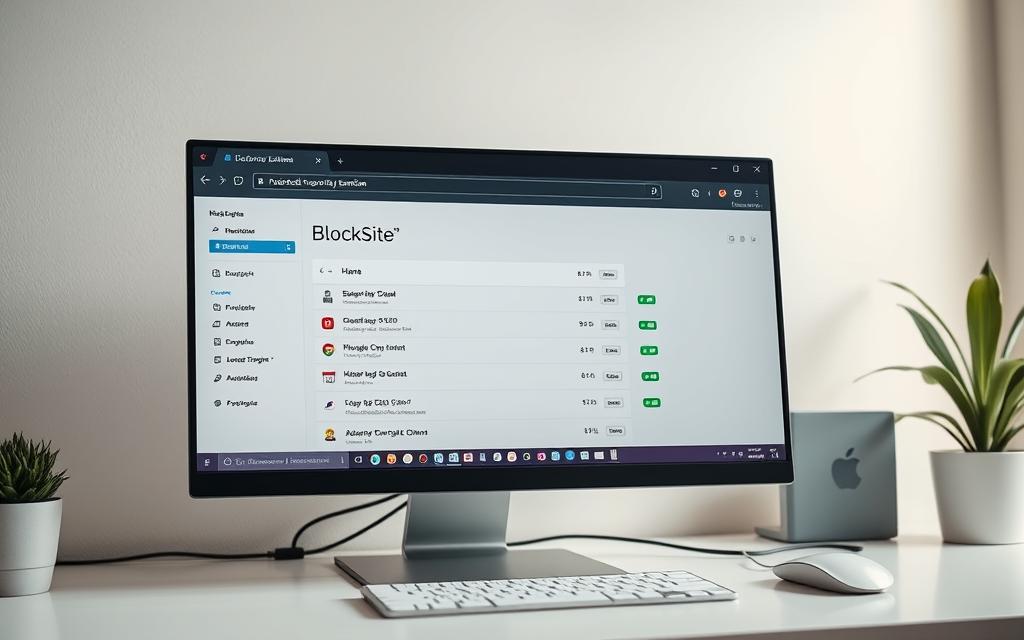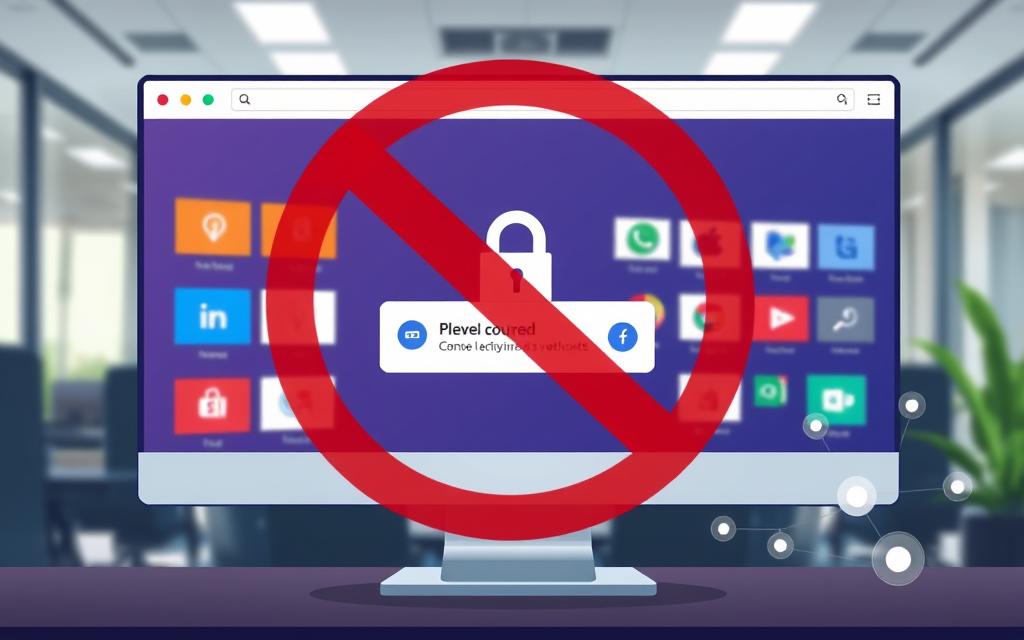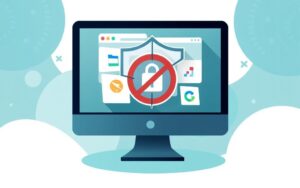Table of Contents
Blocking websites in Chrome offers various ways to manage web content access. You can use extensions, parental controls, or edit system files. These methods help filter harmful content and boost productivity.
Chrome’s built-in tools and third-party extensions like BlockSite provide user-friendly options. They allow you to block websites effectively and easily.
Website blocking can restrict explicit content for children. It can also reduce distractions during work or study time. Furthermore, it helps prevent exposure to malware from dangerous sites.
Understanding Website Blocking in Chrome: Benefits and Use Cases
Chrome’s website blocking feature offers valuable benefits for various user needs. It helps safeguard against harmful content and boosts online productivity. This tool allows users to control and manage web access effectively.
Protection Against Harmful Content
The internet can be risky, with websites containing explicit or malicious content. Chrome’s blocking feature shields users from such harmful material. It restricts access to inappropriate or dangerous websites, creating a safer online environment.
This tool is especially useful for parents guarding their children’s online activities. It contributes to internet safety by limiting exposure to potentially harmful content.
Productivity Enhancement
Chrome’s website blocking can boost online productivity in our distraction-filled digital world. It helps users focus by restricting access to time-wasting websites. This feature benefits those struggling with work-life balance and organisations aiming to improve efficiency.
Parental Control Benefits
Website blocking in Chrome offers a valuable solution for child protection. Parents can control their children’s internet access, ensuring a safer online environment. This feature allows active monitoring of children’s internet usage.
It empowers parents to curate their children’s digital experience. The tool promotes web content management and fosters a healthier online environment for children.
Chrome’s website blocking feature is versatile and important. It allows users to customise their online experience and protect against potential threats. This tool enhances overall internet safety and productivity for various user groups.
How to Block a Website in Chrome PC: Basic Method Using Extensions
Chrome lacks a built-in website blocking feature for all users. However, browser extensions offer a simple solution. These Chrome extensions, or website blockers, serve as user-friendly content filtering tools.
BlockSite, a popular extension with over three million downloads, is a prime example. It allows users to block sites directly from the browser or extension dashboard.
Many extensions offer focus mode, word-based blocking, and scheduling features. Free versions typically limit the number of blocked sites. Premium versions unlock more advanced capabilities.
- Chrome doesn’t offer a built-in option for every user to block websites
- The easiest way to block websites on Chrome is with an extension
- BlockSite is a popular extension with over three million downloads
- Extensions offer features like focus mode, word-based blocking, and scheduling
- Free versions allow blocking a limited number of sites, while premium versions offer more advanced features
These website blockers and browser add-ons help Chrome users manage online content effectively. Content filtering tools empower users to control their digital environment. These Chrome extensions boost productivity and enhance the overall browsing experience.
Using BlockSite Extension: Step-by-Step Guide
Managing online distractions is crucial for productivity and well-being. The BlockSite extension is a popular Chrome tool. It lets you block websites and control your browsing experience.
Installing BlockSite Extension
Visit the Chrome Web Store to add BlockSite to your browser. The process is quick and user-friendly. You can start configuring your blocking preferences right away.
Configuring Block Settings
- Block websites by clicking the BlockSite icon or using the extension’s dashboard.
- The extension can block sites in incognito mode for a consistent experience.
- Customise settings to schedule website access or apply domain-level blocks.
Advanced BlockSite Features
BlockSite offers powerful features to boost productivity and focus:
- Focus Mode: Temporarily disable all blocked sites for deep work.
- Word-based Blocking: Block websites containing specific keywords.
- Category-based Blocking: Block entire categories like social media or entertainment.
- Redirect Options: Send blocked websites to a custom URL.
- Scheduling: Set specific times for website blocking or access.
BlockSite works on desktop and mobile devices. This ensures consistent website blocking across all your gadgets.

“BlockSite has been a game-changer for my productivity. The ability to block distracting websites has helped me stay focused and on track with my work and studies.”
BlockSite is a versatile tool for boosting productivity. It’s great for personal use or parental controls. The extension helps you take charge of your online habits.
Windows Parental Controls for Website Blocking
Windows offers strong parental controls to shield children from harmful online content. You can set up a child account and use content filters to block unwanted websites. This helps create a safer online environment for your kids.
To start, go to the Settings menu and select Accounts. Then, choose Family & other users to add a child account. Enable parental controls to access the Content filters tab.
In the Web and search section, you can list websites to block. This feature gives you control over your child’s online access.
The Google Family Link app offers another way to manage website access on mobile devices. It lets you set Chrome settings and block sites on your children’s accounts.
| Feature | Description |
|---|---|
| Microsoft Family Safety | Windows’ built-in parental control system for setting up child accounts and filtering web content |
| Child Account Setup | Creating a separate user account for children, enabling customised settings and restrictions |
| Content Filtering | Blocking specific websites and domains to protect children from inappropriate or harmful online content |
These parental control features help create a safe online space for children. They also encourage good digital habits and boost productivity.
Advanced Method: Editing Hosts File for Website Blocking
Editing the hosts file offers a robust way to block websites on Windows PCs. This method works across all browsers and apps on your device.
The hosts file is in the C:\Windows\System32\drivers\etc directory. It redirects specific website addresses to a local IP address, stopping access to those sites.
Windows Hosts File Modification
To block websites using the hosts file, follow these steps:
- Open the hosts file with administrative privileges, either by right-clicking the file and selecting “Edit as administrator” or by using the Command Prompt and typing
notepad.exe C:\Windows\System32\drivers\etc\hosts. - Add a new line to the file, starting with the IP address
127.0.0.1, followed by a space and the domain name of the website you wish to block. For example:127.0.0.1 www.example.com. - Save the file and exit the editor.
- Clear your browser’s cache to ensure the changes take effect immediately.
Troubleshooting Common Issues
Editing the hosts file is powerful, but requires caution. Improper changes can cause system-wide issues.
Be mindful of these troubleshooting tips:
- Ensure you have the necessary administrative privileges to edit the hosts file.
- Double-check your syntax and entry format to avoid any mistakes that could disrupt your system.
- If you encounter any unexpected behavior or system instability, revert the changes by removing the added lines from the hosts file.
Backup and Safety Measures
Create a backup of the original hosts file before making changes. This allows easy restoration of the default setup if needed.
Learn about the hosts file’s structure and purpose. Understanding its implications helps you make informed decisions and reduce risks.
Chrome’s Built-in Tools and Settings for Content Control
Google Chrome provides tools to manage web content. SafeSearch, enabled in Google account preferences, filters explicit material from search results. This feature creates a safer browsing experience for families and children.
Chrome Enterprise admins can use the BlockList URL feature in the Google Admin Console. This tool manages website access across multiple devices within an organisation. Admins can block specific URLs, protecting employees from harmful content during work hours.
| Feature | Description |
|---|---|
| SafeSearch | Filters explicit content from Google search results to provide a safer browsing experience. |
| Chrome Enterprise BlockList URL | Enables administrators to block specific websites or services for all Chrome users within an organisation. |
| Google Account Settings | Allows users to manage their personal content preferences and restrictions, including SafeSearch settings. |
These built-in tools help users and organisations control their online content. They promote a safer, more productive, and responsible internet experience. Users can tailor their browsing to suit their needs and values.
Conclusion
Chrome on PC offers various website blocking methods for a secure and focused online experience. Users can choose from user-friendly extensions like BlockSite or advanced techniques such as editing the hosts file. These solutions cater to different technical abilities and needs.
Windows parental controls and Chrome’s content management tools provide extra layers of customisation. These features help manage online distractions and protect against harmful content. They also promote a more productive digital experience.
The best blocking approach depends on your goals and technical know-how. You can protect children, boost productivity, or create a focused online environment. Chrome on PC offers versatile solutions to meet various needs and preferences.
FAQ
What are the benefits of blocking websites in Chrome on a PC?
Blocking websites in Chrome on PC helps manage web content access. It protects against explicit content, fraud, and malware. This enhances productivity by restricting distracting websites and allows for parental control.
What are the different methods available for blocking websites in Chrome on a PC?
Several methods exist for blocking websites in Chrome on a PC. These include using extensions, parental controls, and editing system files. Each technique caters to different user needs and technical skill levels.
How can I use the BlockSite extension to block websites in Chrome?
To use BlockSite, add the extension from the Chrome Web Store. Block websites by clicking the BlockSite icon or through the extension’s dashboard. BlockSite offers features like focus mode, word-based blocking, and scheduling.
How can I use Windows 11 parental controls to block websites in Chrome?
Windows 11 has built-in parental controls for website blocking. Set up a child account in Windows settings. Then, access the Microsoft account page to configure content filters. You can add specific URLs or domain names to the block list.
What is the advanced method of editing the hosts file to block websites in Chrome?
Editing the hosts file blocks websites across all browsers and apps. For Windows, access the file in C:\Windows\System32\drivers\etc. Add lines with localhost IP (127.0.0.1) followed by website domains to block.
Save changes and clear the browser cache. This method requires technical knowledge and caution to avoid system issues.
What built-in tools does Chrome offer for content control?
Chrome offers built-in tools for content control. Enable SafeSearch in Google account preferences to filter explicit content from search results. For organisations, Chrome Enterprise admins can use the BlockList URL feature via Google Admin Console.









